
About Low Isles Preservation Society
The Low Isles Preservation Society (LIPS) is a conservation group dedicated to the protection and preservation of the Low Isles, and the marine, coastal and historic values of the surrounding areas.
In 1992, the Australian Maritime Authority announced it was removing the lighthouse keepers from Low Isles and automating the lighthouse. The Great Barrier Reef Marine Park Authority (GBRMPA), to whom the title was to be transferred, was uncertain of the future of Low Isles, and at a community meeting expressed concerns of under-resourcing. Local Douglas Shire community members stepped up to the challenge, creating a working group to organise a public meeting to rally support for saving Low Isles from being exploited by unsustainable visitation and use.
Over 200 local residents attended the meeting, voting to form an incorporated organisation to protect and protoe Low Isles, and to further education. A steering committee was elected, and they spent hundreds of volunteer hours creating a draft proposal for the protection of Low Isles through community participation and involvement in caretaking. Thus LIPs was born, with the proposal well received by all stakeholders, including GBRMPA and the Queensland Parks and Wildlife Service (QPWS). Confidence in the model of voluntary community engagement was demonstrated by the grant of $1.5 million in Federal government funding.
The community became involved in the co-management of low isles, and in developing programmes designed for research, interpretation and protection of the Great Barrier Reef.
At present, a voluntary executive committee runs LIPS. Full time caretakers are employed by GBRMPA, and reside on the island. LiPS volunteers continue their involvement by acting as relief caretakers , being involved in maintenance and restoration projects on the island, and conducting pied imperial pigeon counts.
LIPS Committee for 2023-2024
President Mark Colbridge
Vice President Jill Bickford
Secretary Kath Anich
Projects Secretary Renata Musson
Treasurer Col Musson
We also extend a warm welcome to Dusty Howman who has come onboard as our PIP count coordinator, assisted by Leanne Kruger.
Image Credit / Murray Views Collection c1970
Image Credit / Murray Views Collection c1970
Image Credit / Murray Views Collection c1970
About Low Isles
Low Isles is an inner patch reef 15 km north-east of Port Douglas. It is composed of a small coral cay ( Low Island) and a larger mangrove island (Woody Island), growing on top of senile coral reef. It has ecological importance due to the co-existence of a number of fully developed marine and terrestrial ecosystems.The combination of coral cay and mangrove island type is unique to the Great Barrier Reef. The hook-like shape, which provides a sheltered lagoon, is also an excellent refuge and an ideal feeding ground for a large population of adolescent turtles.
At Low Isles is an important indigenous cultural site for both the KuKu Yalanji and Yirraganydji people. The sea country of both groups overlaps at Low Isles, and the islands are known as ‘Wungkun’ to the local Indigenous people.
English explorer, Captain James Cook, recorded the existence of the islands in 1770 during his voyage to Australia. He described Low Island as “a small low island”. It was officially named Low Isles in 1819.
A lighthouse was built on the coral cay in 1878. It was the tenth commissioned by the Queensland Government to help create the longest shipping lane in the world. There was a continuous presence of lighthouse keepers on Low isles up until 1993, when the lighthouse became automated.
Between 1928 – 1929, Low Isles was the site of the first detailed scientific study of a coral reef anywhere in the world. The expedition, led by Dr C.M. Yonge aimed to study the life processes of coral and of the formation and maintenance of the reef. More than 20 renowned natural scientists spent up to 13 months at Low Isles. Results from the expedition were published by the British Natural History Museum in six large volumes. The expedition created a set of base line data, which is invaluable today for comparison with modern research, in order to study change on the Great Barrier Reef.
Water quality has significantly decreased in the lagoon area due to coastal human activity and the increase of tourist numbers. The numbers are now strictly regulated and a human waste treatment plant has been installed to render human waste harmless.

More about the history of Low Isles lighthouse
BACKGROUND IMAGE CREDIT / Syd Pipe c.1970 via Queensland Places



